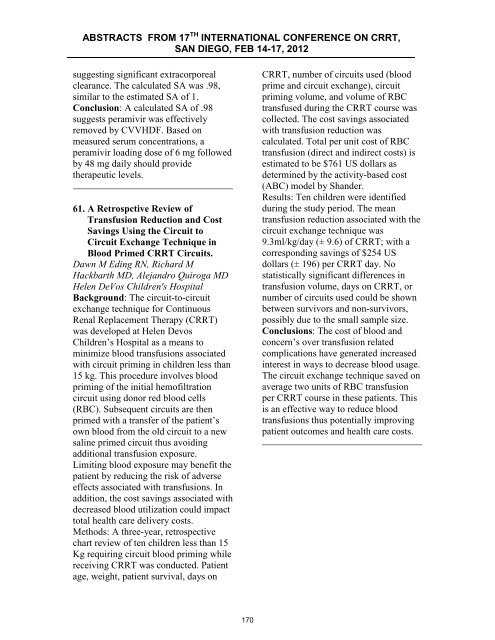ABSTRACTS from 16th International COnference on ... - CRRT Online
ABSTRACTS from 16th International COnference on ... - CRRT Online
ABSTRACTS from 16th International COnference on ... - CRRT Online
You also want an ePaper? Increase the reach of your titles
YUMPU automatically turns print PDFs into web optimized ePapers that Google loves.
<str<strong>on</strong>g>ABSTRACTS</str<strong>on</strong>g> FROM 17 TH INTERNATIONAL CONFERENCE ON <strong>CRRT</strong>,<br />
SAN DIEGO, FEB 14-17, 2012<br />
suggesting significant extracorporeal<br />
clearance. The calculated SA was .98,<br />
similar to the estimated SA of 1.<br />
C<strong>on</strong>clusi<strong>on</strong>: A calculated SA of .98<br />
suggests peramivir was effectively<br />
removed by CVVHDF. Based <strong>on</strong><br />
measured serum c<strong>on</strong>centrati<strong>on</strong>s, a<br />
peramivir loading dose of 6 mg followed<br />
by 48 mg daily should provide<br />
therapeutic levels.<br />
61. A Retrospctive Review of<br />
Transfusi<strong>on</strong> Reducti<strong>on</strong> and Cost<br />
Savings Using the Circuit to<br />
Circuit Exchange Technique in<br />
Blood Primed <strong>CRRT</strong> Circuits.<br />
Dawn M Eding RN, Richard M<br />
Hackbarth MD, Alejandro Quiroga MD<br />
Helen DeVos Children's Hospital<br />
Background: The circuit-to-circuit<br />
exchange technique for C<strong>on</strong>tinuous<br />
Renal Replacement Therapy (<strong>CRRT</strong>)<br />
was developed at Helen Devos<br />
Children’s Hospital as a means to<br />
minimize blood transfusi<strong>on</strong>s associated<br />
with circuit priming in children less than<br />
15 kg. This procedure involves blood<br />
priming of the initial hemofiltrati<strong>on</strong><br />
circuit using d<strong>on</strong>or red blood cells<br />
(RBC). Subsequent circuits are then<br />
primed with a transfer of the patient’s<br />
own blood <str<strong>on</strong>g>from</str<strong>on</strong>g> the old circuit to a new<br />
saline primed circuit thus avoiding<br />
additi<strong>on</strong>al transfusi<strong>on</strong> exposure.<br />
Limiting blood exposure may benefit the<br />
patient by reducing the risk of adverse<br />
effects associated with transfusi<strong>on</strong>s. In<br />
additi<strong>on</strong>, the cost savings associated with<br />
decreased blood utilizati<strong>on</strong> could impact<br />
total health care delivery costs.<br />
Methods: A three-year, retrospective<br />
chart review of ten children less than 15<br />
Kg requiring circuit blood priming while<br />
receiving <strong>CRRT</strong> was c<strong>on</strong>ducted. Patient<br />
age, weight, patient survival, days <strong>on</strong><br />
<strong>CRRT</strong>, number of circuits used (blood<br />
prime and circuit exchange), circuit<br />
priming volume, and volume of RBC<br />
transfused during the <strong>CRRT</strong> course was<br />
collected. The cost savings associated<br />
with transfusi<strong>on</strong> reducti<strong>on</strong> was<br />
calculated. Total per unit cost of RBC<br />
transfusi<strong>on</strong> (direct and indirect costs) is<br />
estimated to be $761 US dollars as<br />
determined by the activity-based cost<br />
(ABC) model by Shander.<br />
Results: Ten children were identified<br />
during the study period. The mean<br />
transfusi<strong>on</strong> reducti<strong>on</strong> associated with the<br />
circuit exchange technique was<br />
9.3ml/kg/day (± 9.6) of <strong>CRRT</strong>; with a<br />
corresp<strong>on</strong>ding savings of $254 US<br />
dollars (± 196) per <strong>CRRT</strong> day. No<br />
statistically significant differences in<br />
transfusi<strong>on</strong> volume, days <strong>on</strong> <strong>CRRT</strong>, or<br />
number of circuits used could be shown<br />
between survivors and n<strong>on</strong>-survivors,<br />
possibly due to the small sample size.<br />
C<strong>on</strong>clusi<strong>on</strong>s: The cost of blood and<br />
c<strong>on</strong>cern’s over transfusi<strong>on</strong> related<br />
complicati<strong>on</strong>s have generated increased<br />
interest in ways to decrease blood usage.<br />
The circuit exchange technique saved <strong>on</strong><br />
average two units of RBC transfusi<strong>on</strong><br />
per <strong>CRRT</strong> course in these patients. This<br />
is an effective way to reduce blood<br />
transfusi<strong>on</strong>s thus potentially improving<br />
patient outcomes and health care costs.<br />
170
















